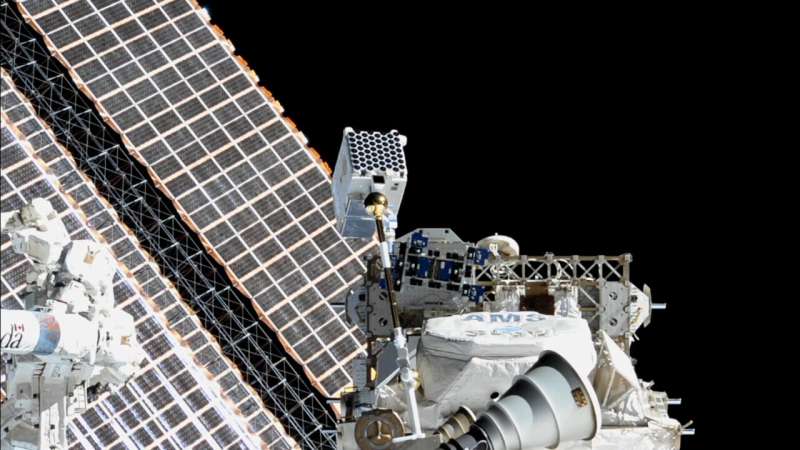
Copernical Team
NASA gears up for another Mars simulation mission
 In an effort to further humanity's journey to Mars, NASA has carefully selected a diverse group of four volunteers to undergo an intensive 45-day simulated mission to the Red Planet. This simulation will take place at the Johnson Space Center's Human Exploration Research Analog (HERA), a facility meticulously designed to mimic the conditions of space travel and planetary exploration.
Parti
In an effort to further humanity's journey to Mars, NASA has carefully selected a diverse group of four volunteers to undergo an intensive 45-day simulated mission to the Red Planet. This simulation will take place at the Johnson Space Center's Human Exploration Research Analog (HERA), a facility meticulously designed to mimic the conditions of space travel and planetary exploration.
Parti Lunar i-hab mockup completes acceptance review at Thales Alenia Space
 The European Space Agency's Lunar I-Hab initiative has achieved a significant milestone at the Thales Alenia Space facility in Turin with the completion of the Acceptance Review of the mockup, delivered by Liquifer Space Systems. This event underscores the advancement toward a sustained human presence in lunar orbit.
The mockup, a full-scale version of the intended flight module, includes
The European Space Agency's Lunar I-Hab initiative has achieved a significant milestone at the Thales Alenia Space facility in Turin with the completion of the Acceptance Review of the mockup, delivered by Liquifer Space Systems. This event underscores the advancement toward a sustained human presence in lunar orbit.
The mockup, a full-scale version of the intended flight module, includes Max Space unveils new expandable space habitats
 During the 39th Space Symposium, Max Space, a pioneering space company, showcased its innovative expandable habitat technology. This technology is distinguished by its ability to scale indefinitely while ensuring structural stability, positioning Max Space as a unique player in the space habitation sector. This capability is anticipated to facilitate mass production and significantly lower the c
During the 39th Space Symposium, Max Space, a pioneering space company, showcased its innovative expandable habitat technology. This technology is distinguished by its ability to scale indefinitely while ensuring structural stability, positioning Max Space as a unique player in the space habitation sector. This capability is anticipated to facilitate mass production and significantly lower the c Census of cosmic neighbors reveals new insights with help from citizen scientists
 Using various telescopes, scientists, including volunteer citizen scientists worldwide, have mapped over 3,500 cosmic entities within 65 light-years of the Sun through the Backyard Worlds: Planet 9 project.
A recent study published in The Astrophysical Journal details these findings, highlighting that stars outnumber brown dwarfs by four to one in this sector, yet low-mass objects prevail
Using various telescopes, scientists, including volunteer citizen scientists worldwide, have mapped over 3,500 cosmic entities within 65 light-years of the Sun through the Backyard Worlds: Planet 9 project.
A recent study published in The Astrophysical Journal details these findings, highlighting that stars outnumber brown dwarfs by four to one in this sector, yet low-mass objects prevail Φsat-2 gets two new AI apps

Φsat-2, ESA’s groundbreaking cubesat scheduled for launch in June, will now include two new AI-driven apps destined to demonstrate a crucial role in future environmental monitoring from space. The apps, which focus on marine pollution and wildfires, were the winning entries in ESA’s OrbitalAI Challenge.
SpaceX launches Falcon 9, carrying 23 Starlink satellites from Florida
 SpaceX launched its Falcon 9 rocket, carrying 23 Starlink satellites into low-Earth orbit early Wednesday evening, under clear, sunny skies in Florida.
"Merlin engine ignition and liftoff of Falcon 9!" SpaceX wrote in a post on X.
"Five, four, three, two, one, zero, mission liftoff," as video of the launch shows the 230-foot rocket lifting off at 5:26 p.m. EDT from Launch Complex
SpaceX launched its Falcon 9 rocket, carrying 23 Starlink satellites into low-Earth orbit early Wednesday evening, under clear, sunny skies in Florida.
"Merlin engine ignition and liftoff of Falcon 9!" SpaceX wrote in a post on X.
"Five, four, three, two, one, zero, mission liftoff," as video of the launch shows the 230-foot rocket lifting off at 5:26 p.m. EDT from Launch Complex Astronauts to patch up NASA's NICER telescope

NASA is planning to repair NICER (Neutron star Interior Composition Explorer), an X-ray telescope on the International Space Station, during a spacewalk later this year. It will be the fourth science observatory in orbit serviced by astronauts.
China gears up for Shenzhou XVIII manned space mission
 The China Manned Space Agency has announced that the Shenzhou XVIII mission is poised for launch in the upcoming days, aiming to deliver three astronauts to the Tiangong space station.
On Wednesday, the Shenzhou XVIII crew spacecraft, along with its Long March 2F rocket, was transferred to the service tower at the Jiuquan Satellite Launch Center located in the Gobi Desert of northwestern C
The China Manned Space Agency has announced that the Shenzhou XVIII mission is poised for launch in the upcoming days, aiming to deliver three astronauts to the Tiangong space station.
On Wednesday, the Shenzhou XVIII crew spacecraft, along with its Long March 2F rocket, was transferred to the service tower at the Jiuquan Satellite Launch Center located in the Gobi Desert of northwestern C How to Tell Space Rocks from Space Junk
 Upcoming surveys will find dozens of near-Earth objects each night, but some of those objects will be space junk rather than asteroids. How will we tell the difference?
b>Masquerading as Asteroids br> /b>
When humankind sent its first rocket toward the Moon 65 years ago, it marked the beginning of a long era of lunar exploration. Now, the cast-off rocket parts from decades of lunar missi
Upcoming surveys will find dozens of near-Earth objects each night, but some of those objects will be space junk rather than asteroids. How will we tell the difference?
b>Masquerading as Asteroids br> /b>
When humankind sent its first rocket toward the Moon 65 years ago, it marked the beginning of a long era of lunar exploration. Now, the cast-off rocket parts from decades of lunar missi GDFAU joins NASA for university nanosatellite project
 Florida Atlantic University's College of Engineering and Computer Science has been chosen as one of eight U.S. university teams to collaborate with NASA and the U.S. military. This partnership aims to boost innovation and expertise in the small satellite sector through the 2024 Mission Concept Program.
The program, a part of NASA's CubeSat Launch Initiative (CSLI), involves cooperation wit
Florida Atlantic University's College of Engineering and Computer Science has been chosen as one of eight U.S. university teams to collaborate with NASA and the U.S. military. This partnership aims to boost innovation and expertise in the small satellite sector through the 2024 Mission Concept Program.
The program, a part of NASA's CubeSat Launch Initiative (CSLI), involves cooperation wit 































